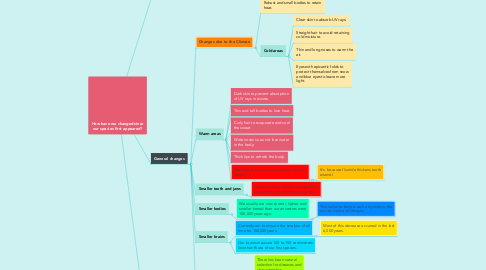
1. Regional changes
1.1. Have developed physical and genetic characteristics to adapt to different environments.
2. Universal changes
2.1. The visible changes
2.1.1. The size of the body, the mouth the head, and the brain have reduced.
3. General changes
3.1. Changes due to the Climate
3.1.1. Robust and small bodies to retain heat.
3.1.2. Cold areas
3.1.2.1. Clear skin to absorb UV rays.
3.1.2.2. Straight hair to avoid retaining cold moisture.
3.1.2.3. Thin and long noses to warm the air.
3.1.2.4. Eyes with epicantic folds to protect themselves from snow and blue eyes to leave more light.
3.2. Warm areas
3.2.1. Dark skin to prevent absorption of UV rays in excess.
3.2.2. Thin and tall bodies to lose heat.
3.2.3. Curly hair to evaporate and cool the sweat.
3.2.4. Wide noses so as not lose water in the body.
3.2.5. Thick lips to refresh the body.
3.2.6. The teeth have increased in size in the last century.
3.2.6.1. It's because fluoride thickens tooth enamel.
3.3. Smaller teeth and jaws
3.3.1. Dental and mandibular changes have occurred in proportion to body size.
3.4. Smaller bodies
3.4.1. We usually are now shorter, lighter and smaller boned than our ancestors were 100,000 years ago.
3.4.1.1. This is due to factors such as genetics, the environment and lifestyle.
3.5. Smaller brains
3.5.1. Currently our brains are the smallest of all time for 100,000 years.
3.5.1.1. Most of this decrease occurred in the last 6,000 years.
3.5.2. Our brains measure 100 to 150 centimeters less than those of our first species.
3.6. Diversity of appearance
3.6.1. There has been natural selection for diseases and characteristics.
3.6.2. The rate of DNA modification has accelerated in the last 40,000 years.
3.6.3. The physical characteristics are due to the DNA and the adaptation of the environment.
